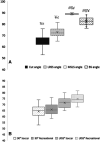The Force-Vector Theory Supports Use of the Laterally Resisted Split Squat to Enhance Change of Direction
- PMID: 38662881
- PMCID: PMC11042517
- DOI: 10.1519/JSC.0000000000004706
The Force-Vector Theory Supports Use of the Laterally Resisted Split Squat to Enhance Change of Direction
Abstract
Cooley, C, Simonson, SR, and Maddy, DA. The force-vector theory supports use of the laterally resisted split squat to enhance change of direction. J Strength Cond Res 38(5): 835-841, 2024-The purpose of this study was to challenge the conventional change of direction (COD) training methods of the modern-day strength and conditioning professional. A new iteration of the modified single-leg squat (MSLS), the laterally resisted split squat (LRSS), is theorized to be the most effective movement for enhancing COD performance. This study lays out a rationale for this hypothesis by biomechanically comparing the LRSS, bilateral back squat (BS), and MSLS with a COD task (90-degree turn). One repetition maximum (1RM) for LRSS, MSLS, and BS was measured for 23 healthy active female subjects. Peak ground reaction forces (GRF) for the dominant leg were recorded when performing COD and the LRSS, MSLS, and BS at 70% 1RM. Peak frontal plane GRF magnitude and angle were calculated for each task and submitted to repeated measures ANOVA. Peak GRF magnitude was significantly larger for COD (2.23 ± 0.62 body weight) than the LRSS, MSLS, and BS (p ≤ 0.001). Peak GRF angle was not significantly different between COD and the LRSS (p = 0.057), whereas the MSLS and BS (p < 0.001) vector angles were significantly greater than COD. In this application of the force-vector theory, the LRSS more closely matches COD than the MSLS or BS. Thus, the LRSS has the greater potential to enhance COD.
Copyright © 2023 The Author(s). Published by Wolters Kluwer Health, Inc. on behalf of the National Strength and Conditioning Association.
Figures




References
-
- Abade E, Silva N, Ferreira R, et al. . Effects of adding vertical or horizontal force-vector exercises to in-season general strength training on jumping and sprinting performance of youth football players. J Strength Cond Res 35: 2769–2774, 2021. - PubMed
-
- Besier TF, Lloyd DG, Ackland TR. Muscle activation strategies at the knee during running and cutting maneuvers. Med Sci Sports Exerc 35: 119–127, 2003. - PubMed
-
- Brughelli M, Cronin J, Levin G, Chaouachi A. Understanding change of direction ability in sport. A review of resistance training studies. Sports Med 38: 1045–1063, 2008. - PubMed
-
- Brzycki M. Strength testing: Predicting a one-rep max from reps-to-fatigue. J Phys Educ Recreat Dance 64: 88–90, 1993.
-
- Castillo-Rodriguez A, Fernandez-Garcia JC, Chinchilla-Minguet JL, Carnero EA. Relationship between muscular strength and sprints with changes of direction. J Strength Cond Res 26: 725–732, 2012. - PubMed
MeSH terms
LinkOut - more resources
Full Text Sources
Research Materials

